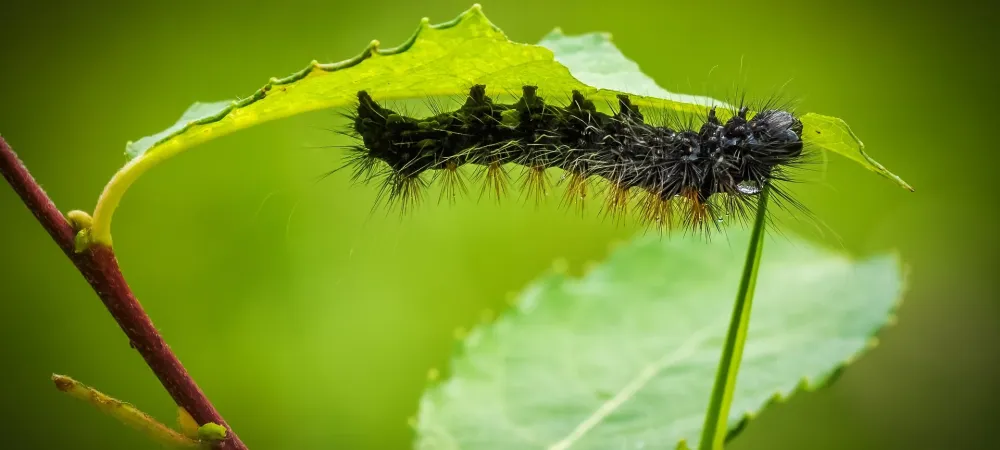Protect Your Hemlock Trees From This Tree Damaging Pest

There is an invasive pest determined to suck the life out of one of our most prized and elegant trees. The Hemlock Woolly Adelgid has destroyed thousands of hemlock trees across the United States and has been found in at least 17 states, including right here in New Jersey. And this tiny insect is smaller than the size of a pencil eraser. Before it impacts your landscape, find out what this tree-damaging insect is, how to identify it and what to do to prevent and control it.
The Elegant Eastern Hemlock
First, let’s talk about the victim of this invasive insect itself, the eastern hemlock. The eastern hemlock is a beautiful evergreen with a broad pyramidal shape, fine, dark-green needles, and an unusual droop instead of the usual point most evergreens have. It resembles a large Christmas tree, and its widely spaced branches contain brown cones that hang from it like small ornaments.
The eastern hemlock is not just a vibrant lawn ornamental. It is used to produce light framing, sheathing, roofing, and subflooring. A good portion of eastern hemlock is used for lumber and paper pulp.
Behavior and Identify of the Hemlock Woolly Adelgid
Why is this tiny, little aphid so detrimental? The Hemlock Woolly Adelgid (HWA) is a small, invasive, sap-sucking insect native to Asia and the Pacific Northwest. It was first noted in the eastern United States in 1951 in a park in Virginia. It is atypical of most insects that infest our trees in New Jersey because it is inactive during the growing season yet very active during the winter. From mid-July until mid-October, they are immature and are flat, black, oval, and contain white waxy strands.
They neither feed nor develop during this time. Instead, the tiny nymphs can be found sitting on the stems of the tree at the base of the needles. In mid-October, they resume feeding using their mouthparts to puncture the hemlock tree’s twigs and suck out the sap. They cover themselves in a white, waxy, “wool,” which acts as a protective coating for the insect.
From then until June, there can be many life-stages present at one time. There are two generations per year, and during this time, much feeding and damage to the hemlock can occur.
From then until June, there can be many life-stages present at one time. There are two generations per year, and during this time, much feeding and damage to the hemlock can occur.
What Types of Symptoms Should I look For on My Hemlock Trees?
Adelgid infestations are easily recognizable by the appearance of tiny “cotton balls” at the base of hemlock needles. The woolly masses generally range from about 1/16-inch to 1/8-inch in diameter. They are most visible from late fall to early summer on the undersides of the outermost branch tips of hemlock trees. Other signs and symptoms include:
- Off color-needles with a grayish cast
- Thinning crowns
- Premature needle loss
- Thinning or dying limbs beginning at the base of the tree and moving upwards
Ultimately, if a hemlock tree is not treated properly for an infestation, it will die. So what can you as a business or homeowner do to prevent and protect your precious hemlock evergreens?
How to Prevent, Care for and Treat Hemlock Woolly Adelgid
Tree and Shrub Care Maintenance Program
A healthy, well-maintained hemlock tree is going to be able to withstand an infestation longer than stressed plants. Hemlocks growing in stressful sites such as compacted soil, soil with poor drainage, or a drought-prone area are much more apt to succumb to death within three to five years of infestation. So first and foremost, invest in the well-being of your lawn ornaments. Not just your hemlock trees, but all of your trees and shrubs. Utilize a tree and shrub care program that offers fertilization to help keep your plants robust and includes disease and insect control to help your trees fight off pests and diseases.
Monitoring
By frequently inspecting trees for signs of HWA, a home or business owner can intervene on time and possibly prevent the tree from dying.
Removal by Hand
You can remove the eggs and adults by simply spraying the twigs with water and/or pruning the most heavily infested branches from the tree. Of course, we recommend hiring a tree care specialist who specializes in this type of work to ensure no further damage occurs to the tree and all infected branches are eliminated.
Use of Horticultural Oils & Other Injections
An infected tree can be treated at any time except when needles emerge. When hemlock woolly is addressed early, spray the affected tree with horticultural oil. Horticultural or dormant oils can be highly effective in killing adelgids yet safe for the tree and the environment. For the application to be effective, it must be sprayed over the entire plant and will need to be reapplied later in the season. You must kill the entire HWA, or the insects will reappear and become even more aggressive.
When to Use Horticultural Oil
The most vulnerable stage of the woolly adelgid is the immature crawler stage. These immature insects are exposed to new growth from June to October, at which time they begin to secrete the white protective wax. That means that here in New Jersey, the best times to inject horticultural oils to prevent HWA are between August and September.
Contact Harvest Lawn Care for Protection of Your Hemlock Trees Now
The time is now. Start protecting your eastern hemlock trees with Harvest Lawn Care's highly effective yet specialized injections explicitly for the protection against Hemlock Scale and Woolly Adelgid, insects that specifically attack the hemlock.
For better and added protection, invest in our Harvest Lawn Care’s Tree and Shrub Care program. Our six-step tree and shrub care program is tailored to the individual needs of your landscape and contains a spring root zone fertilization, foliage protection, dormant oil, and more.